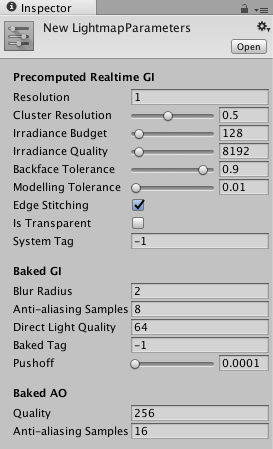- Unity マニュアル
- グラフィックス
- グラフィックスの概要
- ライティング
- グローバルイルミネーション
- ライトマップパラメータ
ライトマップパラメータ
Lightmap Parameters アセットは、プロジェクトビューのメニューから、または ライティングウィンドウ 上のシーンタブから作成できます。パラメータは、Unity の Global Illumination (GI) 機能を使用して、オブジェクトのためにライトマップを生成するプロセスに影響します。使用可能なすべての Lightmap Parameters アセットは、選択を簡単にするためにライティングウィンドウのシーンタブにリストされます。これによって、異なるタイプのオブジェクト、プラットフォーム、シーンなどのために最適化されたプリセットを作成することができます(例えば、屋内/屋外)。
プロパティー

| プロパティー | 機能 |
|---|---|
| Precomputed Realtime GI | |
| Resolution | この値で、距離あたりのテクセルでライトマップの最終的な解像度を与えるために、Scene タブでリアルタイム解像度の値をスケーリングします。 |
| Cluster Resolution | “cluster” の解像度(すなわち、光バウンスが内部で計算されている解像度)の、最終的なライトマップの解像度との比です。 |
| Irradiance Budget | この値は、入射光のデータがライトマップ内の各テクセルを照らすために使用される時の精度を決定します。基本的に、テクセルが自身の位置からシーンの “view” を取得することによって、各テクセルのライティングが得られます(すなわち、入射光のパターンを記録します)。放射照度の量が低い場合は、光のパターンの計測精度が低くなるため、よりぼやけたビューになります。値を高くすると、ビューはよりシャープになります。放射照度の量を上げると、ライティングは改善されますが、メモリ使用量が増加し、いくらか余分な CPU オーバーヘッドが発生する可能性が有ります。 |
| Irradiance Quality | The quality of the transfer of internal light bounce data to the final lightmap texture. Higher values offer visual improvements in the lightmap but at the expense of increased precomputing time in the editor; the value does not affect runtime performance. This property actually refers to the number of rays that are used internally to evaluate the internal data for each lightmap texel. |
| Backface Tolerance | The structure of a mesh can sometimes cause some texels to have a “view” that includes backfaces. Since incoming light from a backface is meaningless, this property lets you select a percentage threshold of that light that must come from front facing geometry in order for a texel to be considered valid. Invalid texels have their lighting approximated from neighbours’ values. |
| Modelling Tolerance | The maximum size of gaps in mesh geometry that can be ignored for GI purposes. |
| Edge Stitching | If enabled, this property indicates that UV “charts” in the lightmap should be joined together seamlessly so as to avoid visual artifacts. |
| Is Transparent | If enabled, the object will appear transparent during the Global Illumination calculations. Backfaces are not contributing and light travels through the surface. This is useful for emissive invisible surfaces. |
| System Tag | A group of objects whose lightmap textures are combined in the same lightmap atlas is known as a “system”. Unity will automatically define additional systems and their accompanying atlases if all the lightmaps can’t be fitted into a single atlas. However, it is sometimes useful to define separate systems yourself, to create dynamically loaded levels, say. By changing the System Tag number, you will force a new system and lightmap to be created. The exact numeric sequence values of the tag are not significant. |
| Baked GI | |
| Blur Radius | The radius (in texels) of the blur filter that is applied to direct lighting during postprocessing. The radius is essentially the distance over which neighbouring texels are averaged out; a larger radius gives a more blurred effect. Higher levels of blur tend to reduce visual artifacts but also soften the edges of shadows. |
| Antialiasing Samples | The degree of antialiasing (ie, reduction of “blocky” texel artifacts) that is applied. |
| Direct Light Quality | The number of rays used to evaluate direct lighting. A higher number of rays tends to produce more accurate soft shadows. |
| Baked Tag | Similar to the System Tag property described above, this number lets you group specific sets of objects together in their own baked lightmaps. As with the System Tag, the exact numeric value is not significant; objects use the same baked lightmap if they have the same Baked Tag value. You don’t have to set this when using the multi scene bake API; grouping is done automatically. |
| Pushoff | The amount to push off geometry for ray tracing, in modelling units. It is applied to all baked lightmaps, so it will affect direct light, indirect light and AO. It is useful for getting rid of unwanted AO or shadowing. It can also be used to remove artefacts on huge objects where floating point precision isn’t high enough to accurately ray trace. |
| Baked AO | |
| Quality | The number of rays that are cast when evaluating ambient occlusion (AO). Higher numbers of rays increase the AO quality. |
| Antialiasing Samples | The degree of antialiasing (ie, reduction of “blocky” texel artifacts) that is applied. |